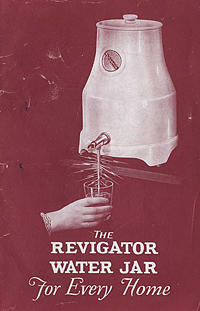
The inventors of the Revigator claimed the device would restore the lost element of water "radio-activity," which "both creates cellular energy and removes cellular poisons." Despite the obvious risk associated with ingesting radioactive substances, researchers at Mount Saint Mary's University in Emmitsburg, Md., working with NIST, discovered that toxic elements dissolved in the water posed the greatest danger.
Radioactive toothpaste, suppositories, makeup: Would-be inventors seeking to capitalize on the discovery of radioactivity in the late 19th century produced a plethora of questionable medical devices and treatments. Among the most famous of these was the Revigator, an earthenware vessel that, according to an advertisement, would infuse drinking water with "the lost element of original freshness—radioactivity." With some technical assistance from the National Institute of Standards and Technology (NIST), researcher Michael Epstein and a group of students at Mount Saint Mary's University in Emmitsburg, Md., discovered that the risk the Revigator posed flowed not so much from the radioactivity, but from the presence of toxic elements dissolved in the water.
The Radium Ore Revigator Company sold several hundred thousand of their glazed ceramic jugs between 1920 and the mid-1930s. The rough, porous inner surface of the Revigator was lined with clay containing carnotite ore, a potassium-uranium-vanadate mineral which released radon into the water as the radium in the ore decayed. According to the manufacturer, the radiation could treat or cure ailments ranging from arthritis and flatulence to senility and poisoning.
"The Revigator was an attempt to mimic spa, or spring water," explains Epstein. "People figured that spring water was radioactive, and it seemed to be good for you, so why not make your own? Most of the literature on the Web has referenced the danger as coming from the radioactivity. My students and I wanted to see if that was true."
Working with NIST scientist Lee Yu, the Mount St. Mary's team set out to determine the extent of the hazards the Revigator might have posed. According to their recent paper,* the researchers measured the amount of radiation emanating from the vessel with a Geiger counter, the radon concentration in the air and water from a jar that had been sealed for one week, and the levels of toxic elements that may have dissolved into water sealed in the jars for one day and one week using a mass spectrometer, a highly sensitive instrument for detecting chemicals and elements.
The team found that radon concentrations in the air and water sampled from jars sealed for one week significantly exceeded the EPA-recommended maximum contaminant levels (MCL). Nevertheless, the team noted that the concentration of radon in the air, given the drafty conditions of an early 20th century home, would not have posed a significant health risk. Moreover, although the levels of radon in the water were high—between 50,000 and 200,000 picoCuries per liter—the study found that, compared to the myriad other disease-related causes of mortality at the time, the chances of dying as a result of drinking radon-infused water were relatively low.
Instead, they found the greatest risks associated with drinking the recommended six to eight daily glasses of "revigated" water was from toxic elements—arsenic, lead, vanadium and uranium—dissolved in the water. Although the concentrations varied with the containers and whether the samples were taken from the top of the containers or from the leaden spout, most of the containers exhibited levels of toxic elements in excess of EPA or OSHA recommendations. Especially striking were the samples of exposed water mixed with a mild acid to mimic wine or fruit juice. Ordinary water kept sealed in one of the jars contained two to twenty times the EPA MCL for arsenic, and some samples showed almost twice as much lead and uranium. The acidified water contained 300 times more arsenic and three times more uranium than the EPA MCL.
"For me, it was quite interesting that people at the time were drinking something that they didn't understand given all that we now know about how harmful these things are to human health," says Yu. "It's amazing to me how eager companies were to commercialize new discoveries without a clear understanding of the risks involved."
* M. Epstein, D.G. Miles Jr., and L.L. Yu. What were they drinking? A critical study of the radium ore revigator. Applied Spectroscopy. Volume 63, Issue 12, Pages 324A-354A and 1315-1442, (December 2009) , pp. 1406-1409(4). DOI: 10.1366/000370209790109003.

